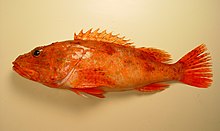| Neomerinthe | |
|---|---|

| |
| Neomerinthe hemingwayi | |
| Scientific classification | |
| Domain: | Eukaryota |
| Kingdom: | Animalia |
| Phylum: | Chordata |
| Class: | Actinopterygii |
| Order: | Perciformes |
| Family: | Scorpaenidae |
| Subfamily: | Scorpaeninae |
| Tribe: | Scorpaenini |
| Genus: | Neomerinthe Fowler, 1935 |
| Type species | |
| Neomerinthe hemingwayi Fowler, 1935 | |
Neomerinthe is a genus of marine ray-finned fish belonging to the family Scorpaenidae, the scorpionfishes. They are found in Atlantic, Indian and Pacific Ocean.
Taxonomy
Neomerinthe was first described as a genus in 1935 by the American ichthyologist Henry Weed Fowler, Fowler was describing N. hemingwayi, with a type locality given as off Cape May, New Jersey, which he designated as the type species of a new genus. The genus name is a compound of neo, meaning new, and Merinthe, a synonym of the genus Pontinus, which Fowler thought N. hemingwayi resembled.
Species
Neomerinthe has 12 species classified within it:
- Neomerinthe amplisquamiceps (Fowler, 1938) (Orange scorpionfish)
- Neomerinthe bauchotae Poss & Duhamel, 1991
- Neomerinthe beanorum (Evermann & M. C. Marsh, 1900)
- Neomerinthe erostris (Alcock, 1896) (Round scorpionfish)
- Neomerinthe folgori (Postel & C. Roux, 1964) (Folger's scorpionfish)
- Neomerinthe hemingwayi Fowler, 1935 (Spiny-cheek scorpionfish)
- Neomerinthe megalepis (Fowler, 1938)
- Neomerinthe naevosa Motomura, Béarez & Causse, 2011 (Blotched Polynesian scorpionfish)
- Neomerinthe pallidimacula (Fowler, 1938) (Three-striped scorpionfish)
- Neomerinthe procurva L. C. Chen, 1981 (Curved-spine scorpionfish)
- Neomerinthe rufescens (C. H. Gilbert, 1905)
Characteristics
Neomerinthe scorpionfishes have an elongate and robust body> they do not have an occipital pit located o the rear of the eyes but there is a bony suborbital ridge under the eye which is armed with 3 spines. The uppermost spine on the preoperculum is longer than the others. There are teeth on the sides of the roof of the mouth. The dorsal fin has 12 spines and 9-10 soft rays, the rearmost ray being split to its base. The pectoral fin is wedge-shaped with 16-18 rats, the longest rays being in the centre and some of the upper rays are branched at their tips in adults. The scales on the body are rough and the lateral line reaches the base of the caudal fin. These scorpionfishes vary in size from a standard length of 7.1 cm (2.8 in) in the curve-spine scorpionfish (N. procurva to a total length of 59 cm (23 in) in Folger's scorpionfish (N. folgeri).
Distribution and habitat
Neomerinthe scorpionfishes are found throughout the world's oceans except for the Eastern Pacific Ocean. They live in deep water.
References
- ^ Eschmeyer, William N.; Fricke, Ron & van der Laan, Richard (eds.). "Genera in the family Scorpaenidae". Catalog of Fishes. California Academy of Sciences. Retrieved 12 January 2022.
- Christopher Scharpf & Kenneth J. Lazara, eds. (2 October 2021). "Order Perciformes (Part 9): Suborder Scorpaenoidei: Family Scorpaenidae". The ETYFish Project Fish Name Etymology Database. Christopher Scharpf and Kenneth J. Lazara. Retrieved 12 January 2022.
- ^ Froese, Rainer; Pauly, Daniel (eds.). "Species in genus Neomerinthe". FishBase. August 2021 version.
- Motomura, H., Causse, R., Béarez, P. & Mishra, S.S. (2015): Redescription of the Indo-West Pacific scorpionfish (Scorpaenidae), Neomerinthe erostris (Alcock 1896), a senior synonym of Scorpaena gibbifrons Fowler 1938, N. rotunda Chen 1981, and N. bathyperimensis Zajonz & Klausewitz 2002. Zootaxa, 4021 (4): 529-540.
- Motomura, H., Béarez, P. & Causse, R. (2011): Review of Indo-Pacific specimens of the subfamily Scorpaeninae (Scorpaenidae), deposited in the Muséum national d'Histoire naturelle, Paris, with description of a new species of Neomerinthe. Cybium, 35 (1): 55-73.
- Motomura, H., Causse, R. & Béarez, P. (2016): Validity of a poorly known western Pacific scorpionfish (Scorpaenidae), Neomerinthe pallidimacula (Fowler, 1938). Cybium, 40 (2): 109-113.
- ^ "Genus: Neomerinthe, Scorpionfishes". Shorefishes of the Greater Caribbean online information system. Smithsonian Tropical research Institute. Retrieved 12 January 2022.
| Taxon identifiers | |
|---|---|
| Neomerinthe | |